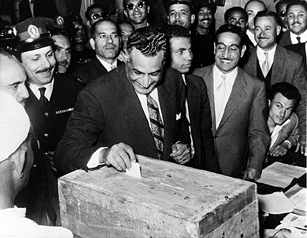1958- Egypt and Syria Join to Form United Arab Republic

Nasser Voting
Nasser was the leading Arab proponent of Pan-Arab Nationalism. He proposed the merging of individual Arab states into one Arab entity. He successfully negotiated the merger of Egypt and Syria into the United Arab Republic. The merger lasted until 1961 when Syrian troops revolted, creating a Syrian Revolutionary Command that declared independence from Egypt.
Gamal Abdel Nasser, born in 1918 and becoming the second president of Egypt in 1956, was not just a revolutionary figure within his homeland, but a principal figurehead in the broader Middle East. His influence extended beyond Egyptian borders, making him the leading Arab proponent of a powerful ideological movement: Pan-Arab nationalism. This ideology sought to unify all Arabic-speaking nations, transcending the existing artificial national borders, and create a singular, grand Arab entity.
Nasser's vision was fueled by a profound sense of regional camaraderie and solidarity, sprung from shared language, religion, and historical experiences. He imagined a Middle East where individual Arab states would willingly merge to form a united Arab entity, a regional power that could stand toe-to-toe with the world's superpowers. His charismatic leadership, powerful oratory skills, and commitment to the Arab cause enabled him to inspire millions across the region, planting the seeds of Pan-Arabism.
In an ambitious attempt to transform his vision into reality, Nasser proposed an alliance that was unheard of at the time - the merger of Egypt and Syria. This proposal was revolutionary, posing a radical shift from the politically fragmented Middle East of the 1950s. His vision was not merely about annexation, but the creation of a new, federated political entity, preserving the cultural and historical identities of both nations, while pooling their political, military, and economic resources for the greater good of the Arab world.
The negotiations were meticulous and intensive, and Nasser's charisma, along with his reputation as a champion of the Arab cause, played a crucial role. Eventually, his efforts bore fruit, leading to the creation of the United Arab Republic (UAR) in 1958, marking a historic milestone in the Arab world. This merger symbolized a tangible realization of Pan-Arabism, stirring hope among Arabs that Nasser's vision might become a reality.
Yet, the United Arab Republic was not destined to last. Nasser's centralizing policies and Egypt's overwhelming dominance within the union provoked discontent among Syrian circles. The seeds of rebellion were sown, culminating in a military coup in 1961. This coup was led by disenchanted Syrian officers who formed the Syrian Revolutionary Command.
The coup marked a significant rupture in the narrative of Pan-Arab unity. The Syrian Revolutionary Command effectively revolted against Nasser's control, emphatically declaring Syria's independence from Egypt. This abrupt dissolution of the United Arab Republic dealt a severe blow to Nasser's dream of a unified Arab entity.
Nevertheless, Nasser's influence on the Arab world and his relentless pursuit of Pan-Arab nationalism left a deep imprint on the Middle East's political landscape. The brief existence of the United Arab Republic echoed his vision and continues to inspire regional unity, albeit in varying forms, even today. His legacy serves as a reminder of the possibility, however transient, of a united Arab entity.
In conclusion, Nasser was a dominant figure in Arab nationalism. His aspiration of merging individual Arab states into a cohesive entity was exemplified in the short-lived United Arab Republic. Despite the union's downfall, Nasser's endeavor remains a testament to the enduring appeal of Pan-Arab unity.
 >
>